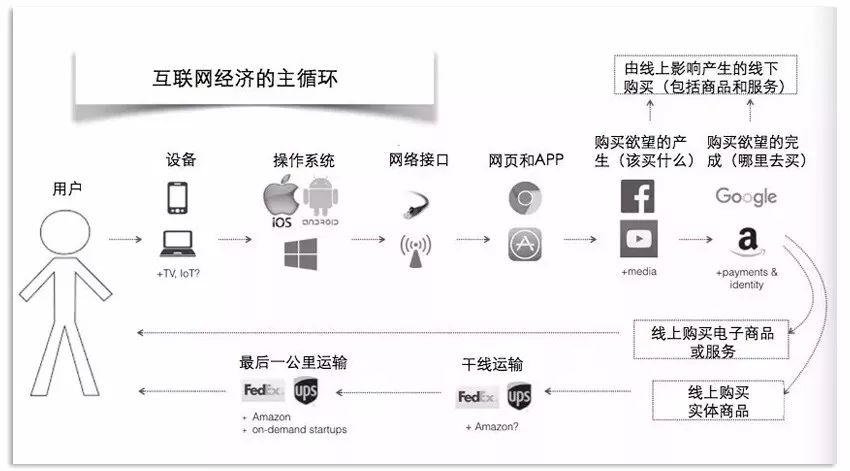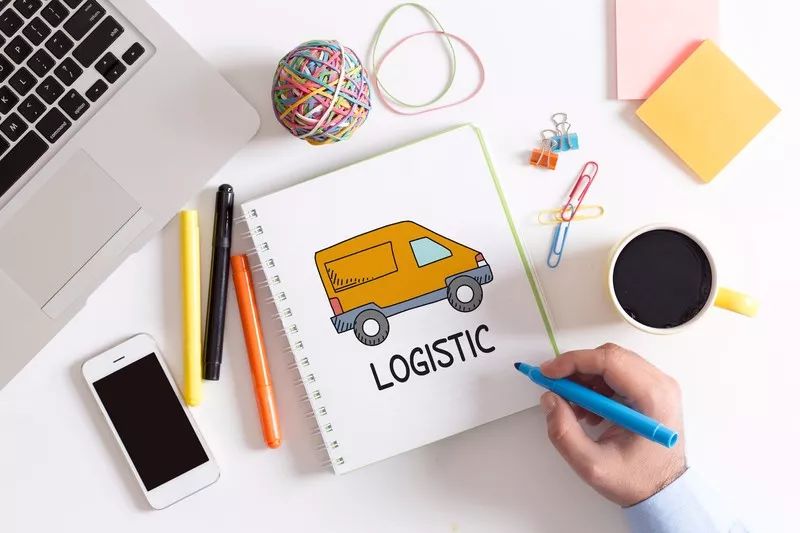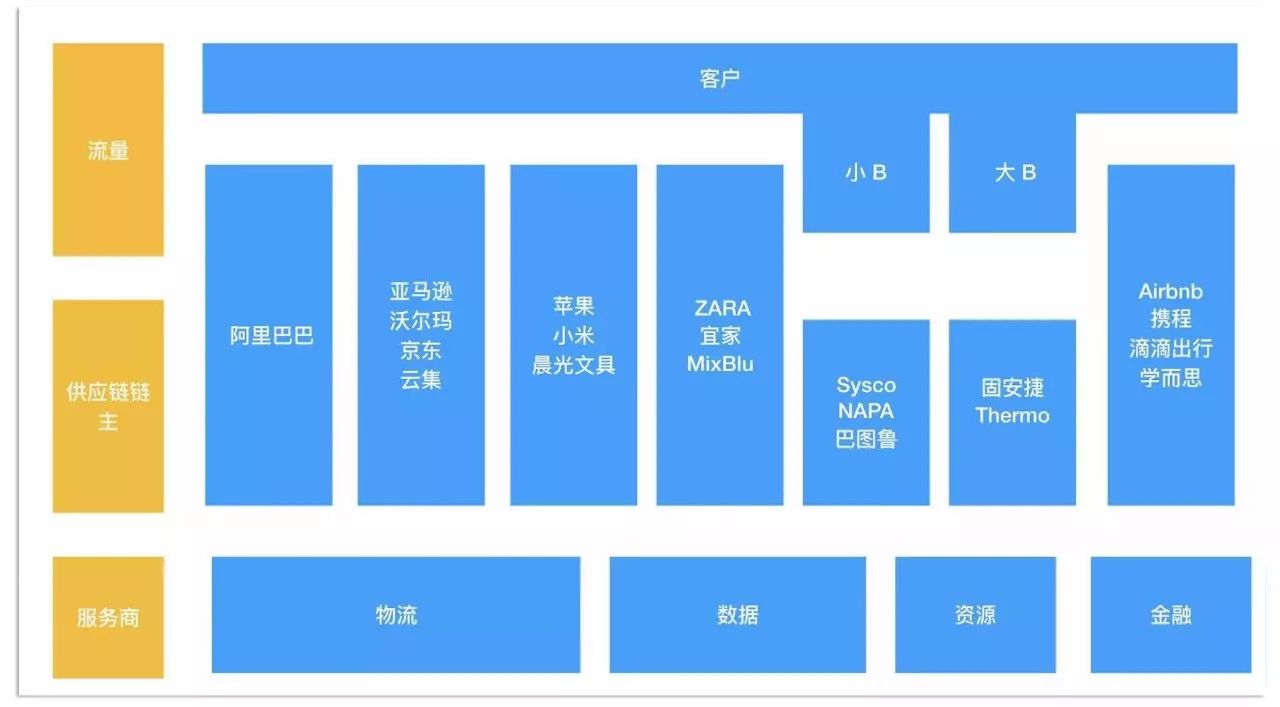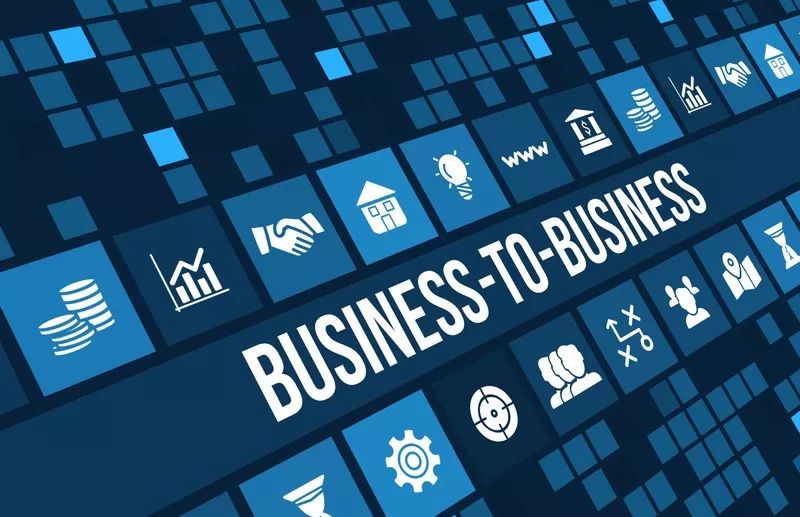Where will the Internet go a few weeks ago? In this article, I mentioned several optimistic 2018 directions. In the past few weeks, I have done some more discussion and thinking, and today I will discuss the opportunities of traditional industries.
This is an old picture, but it often looks new.

Based on this picture, we wrote about the various links in the article of the undercurrent Internet world, and the most understatement is the part of “trunk transportation†and “last mileâ€.
After all, when there are so many online outlets and opportunities, there are several people who care about the supply chain and logistics. When I was doing VC, I tried to look at logistics for a while, and then gave up. Because of the various loads, LTL, leased lines, and feeder lines, this field is really very traditional and complicated.

But in the past few years, the times have changed, and the new retail is so hot that the traffic is going down the line.
First, the Internet A, B categories
Wang Huiwen, the co-founder of the US Mission, made a particularly wonderful sharing a while ago. He divided the entire Internet into Class A and Class B:
Class A is supply and performance online,
Class B is supply and performance online.
The US group is typical of the B category, and looking back, many of the last growing companies in the B category have finally become a focus on the supply chain.
The US group's take-out system is to build a city logistics, a variety of fresh or unmanned convenience stores, etc. It is also doing a retail logistics supply chain, while the unmanned shelves further extend one end of the supply chain into the C-end. In the end, it seems that the 2C business of such companies is just a gimmick. In fact, it is a supply chain company that sells dog meat.
The network provides a complete infrastructure for Class A companies, while Class B companies need to build their own networks in the traditional world. 2C's business has turned out to be the result. The most successful Class B companies are doing supply chain. .
How to understand the supply chain and logistics field, how can we better find entrepreneurial or investment opportunities? With the Internet going to the path of upgrading traditional industries, I believe this issue will be a focus for next year.

In the first two weeks, at the closed-door sharing meeting of Zhong Ding, I heard a lot of big coffee sharing in the supply chain field, including Zhong Ding's own investment methodology, which is very inspiring.
First of all, almost all commercial developments are actually dual-core driven.
For the product side, it is traffic, and for the production side, it is the supply chain. Class A companies are more biased, and Class B companies are more biased toward the supply chain.
Whether it is Internet traffic or offline traffic, the traffic itself solves the problem of getting customers. After getting the guest, how do you solve the problem of retention? The core is customer satisfaction.
Customer satisfaction comes from the experience and efficiency of goods and customer service, and behind this is the supply chain system is supporting. Therefore, many offline companies have chosen to build their own logistics and supply chain, which is the only way to ensure user experience.

And this whole set of service processes is in one sentence:
Supported by data, organize high-quality resources to deliver goods and services to customers at the right time and at the right place, and ultimately solve the customer experience problem with quality, cost and efficiency dimensions.
Second, the "chain owner" on the chain
But under such a long service chain from 2B to 2C, how do you judge and look for opportunities?
Zhong Ding introduced a concept called "chain master" here, which is very interesting.
Who is the most vocal in a chain, who can grasp the commanding heights, who is the chain owner of that chain.
For example, there are four types of typical chain owners in the 2C field.
Alibaba (supermarket platform)
Jingdong (self-operated retail)
Apple (single brand limited SKU)
Zara / IKEA (single brand wide SKU)
They are the most vocal in their respective chains, and only the chain owners can form the most effective organizational power for the entire chain.
Correspondingly, the 2B field also has a chain owner.
To B, such as Sysco for food and beverage outlets abroad, O'Reilly for auto parts, and To B, such as Gu'an Jie, which provides temporary supply of MRO consumables.

And in different areas, there are three dimensions to screen for opportunities:
The first is the category, the second is the model, and the third is the organization.
First and foremost is the choice of categories. Some chains may not have chain owners, or some chain owners are not in the supply chain. For example, energy, chain owners may be at the most upstream resources.
In the entire supply chain of 2B, after sorting out all the international categories, you will find ten major runways, including ingredients, MRO, building materials, and fast-moving. These categories, in the distribution chain of the 2B supply chain, have a big guy of $5 billion internationally.
It is also intrinsically logical that these categories can appear in the circulation. The upstream is very scattered, the number of SKUs is large, and there is enough profit in the category to support its gross profit. It is relatively standardized, or it may be standardized (some industries have not standardized, like ingredients, may not have standardized, it is standardized by food itself) Become an industry standard) and so on.
Then, after setting the category, it is to choose the model and find innovation.
2B's supply chain field has two very intrinsic drivers, the first driver is the consumption upgrade. In the past, most people were paying attention to the consumption upgrade of the C-end. In fact, in the process, the supply chain of the B-side was forced to reform and upgrade.

The second is technology-driven, and today's Internet and IoT technologies provide excellent conditions for the iteration of the entire supply chain system at the B-end.
Driven by these two factors, many of the original traditional businesses will move from decentralization to concentration, and new supply chain owners and large supply chain platforms will emerge in many segments.
In addition, the final measurement of whether a model has genuine innovation, or return to the number, can see the structural improvement of the income cost structure relative to the original model:
Either create more brand premiums or make structural improvements in cost.
After selecting the category and model, the third core is what team to choose.
In the 2B space, several typical qualities of a good team include:
Understand the offline pattern, understand the game
Heavy operation, heavy data
Have start-up resources and organization
After talking with many people in Zhong Ding, I found that the difference between investment in the supply chain and Internet investment is important:
More resources, not more traffic.
Because the client resources on the B side are more visible and need to be integrated, not discovered.
An entrepreneur has resources to explain that he has operated in this industry, and he will be more clear about the offline interests. 2B's business is a traditional business driven by new B-side consumption upgrades and new technologies, from decentralization to concentration, and the creation of new supply chain owners.
That kind of business was originally done by someone. What is the so-called innovation here? It is the process of rebuilding and breaking the old industrial structure and creating a new equilibrium.
Therefore, it must have sufficient knowledge of the original equilibrium system.

What's more, companies that are more inclined to the traditional supply chain believe that more and more companies will rely on the power of mergers and acquisitions to make the company bigger, especially when many of the acquired targets are in the intergenerational handover period.
Finally, let's talk about the concept of the chain owner. If we expand the chain more, the brand, the channel/supply chain, and the user are also a chain of three relationships. Does it also have a chain owner?
Third, consumers become the most worthwhile part of investment
If you think about it carefully, you will find that the brand has absolute right to speak at the earliest. Later, after the Internet innovation, the channel has the right to speak, and now it has begun to surround all consumers.
This also completes the migration of the chain owner.
Therefore, with the logic of Zhongding's investment chain, consumers have now become the most potential part of investment, and as a result, they have begun to use their advantages and resources in the supply chain to start investing in the C-end consumer sector. Extend your investment to the entire industry chain.
So, a very interesting sight is:
Many funds that originally invested in consumption and entertainment began to explore the traditional industry because they could not find a good opportunity, while some funds in the investment supply chain did the opposite.

In fact, Amazon is also a similar way for Internet B-side companies.
After deepening its own supply chain service system, Amazon also began to migrate to customers, including the acquisition of Whole Foods.
As this sentence says:
Amazon has saturated the business of bringing products to people. The next step will be in bringing people to products.
A new rule from the Drug Enforcement Administration (DEA) threatens to upend the American hemp industry, and could even result in criminal prosecutions for manufacturers of CBD and delta-8 THC products.
The DEA says the [interim final rule," issued Aug. 20, is simply a matter of adjusting its own regulations to account for changes to the Controlled Substances Act that were mandated by the 2018 Farm Bill (or Agricultural Improvement Act) that legalized hemp and CBD production. The new rule [merely conforms DEA`s regulations to the statutory amendments to the CSA that have already taken effect," says the agency. The new rule doesn`t break any ground, according to the DEA.
But many experts on cannabis and hemp law say the DEA rule creates a potential pathway the law enforcement agency could use to prosecute hemp processors and producers of CBD (cannabidiol) and delta-8 THC (or Δ8THC) products. There are two issues: partially processed CBD, and [synthetically derived" delta-8 THC.
Cbd Pod System Oem,Cbd Vape Pod Oem,Best Cbd Pod System,Cbd Pod System
Shenzhen MASON VAP Technology Co., Ltd. , https://www.disposablevapepenfactory.com